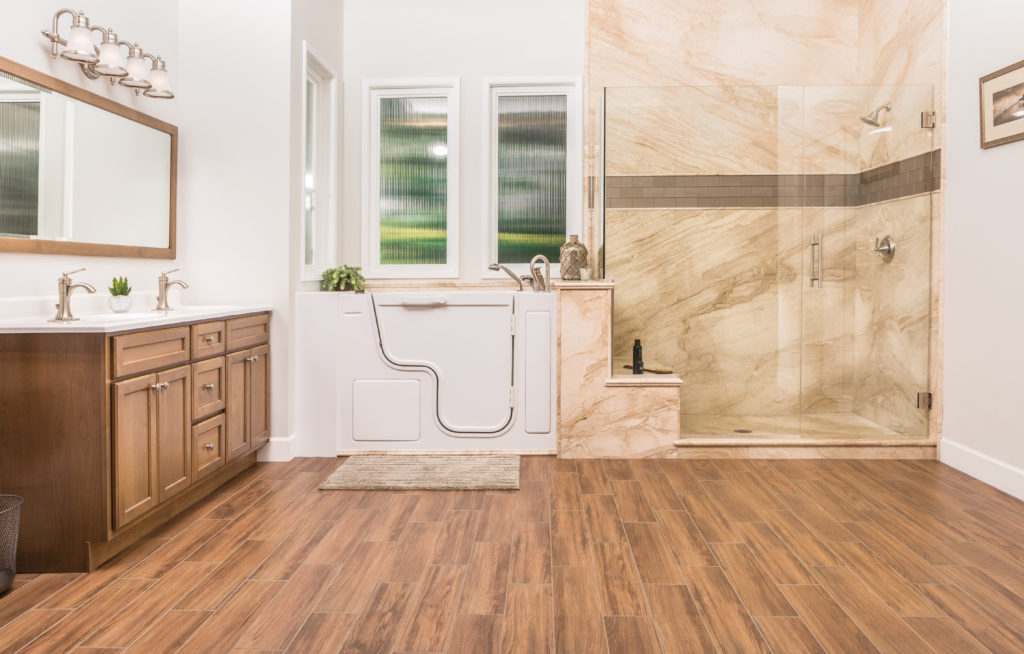Wood Tone Mixing: Dos & Dont’s
Remember when purchasing a full set of matching wood furniture was a thing? Thankfully that look was a passing trend! Other than the obvious design faux pas, the biggest problem with wood furniture sets is that in a room full of matching wood tones, nothing stands out, making the space feel flat and uninspired. When mixed in the right way, though, wood tones can create an eclectic aesthetic that offers just the right amount of interest and depth. Mixing wood isn’t only for furniture—you can use complementary wood tones in your flooring, backsplash, furniture, and accessories to give your home a purposefully organic vibe. If you’re up for the challenge, here are five tips for getting it right.
Mixing Wood Tip #1 Be Mindful of Undertones
You know not to match all the wood tones, but don’t take it to the opposite extreme either. A room filled with different wood tones and styles can look haphazard—probably not the design style you want for your home! Not unlike mixing metals, what’s important to keep in mind is that the finishes you choose complement each other. How? Consider the color bias—the hue that influences your colors. The tones in each wood element should work together. Woods with warm undertones such as cherry, mahogany, and hickory blend well and woods with cool undertones like ash, maple, poplar, and pine can live harmoniously in the same space. But mixing warm and cool (cherry and poplar, for example) can create a messy vibe. If you’re a fan of warm tones but want to add more texture and depth, look for woods with a neutral tone, such as walnut or birch. These are highly versatile in that you can mix them into a room that has warm or cool undertones. Want to mix dark and light woods of varying finishes or add neutral tone wood accents? Great! As long as the wood undertones are consistent, you’re free to play with your design without losing control of the look you’re going for in your home. Especially in the bathroom, where space is at a premium, a single undertone will help the space feel cohesive.
Mixing Wood Tip #2 Maintain the Grain
The grain is another element to consider when mixing woods. There are essentially two types of wood grain: open and closed. Open-grain styles—think soft woods like oak, ash, mahogany and walnut—
have large pores and feel coarse to the touch. Closed-grain species are characterized by small pores and are smooth to the touch—maple, birch, cherry and hickory are all examples of closed-grain woods. If you’re not sure which to choose, think about the style you want to convey. Open-grain wood tends to give off a more casual vibe (perfect in homes with a natural or rustic aesthetic) while closed-grain options work well in more refined environments (traditional and contemporary spaces tend to feature this wood style). Your grain patterns can vary a bit within a room, so long as they aren’t wildly mismatched.
Mixing Wood Tip #3 Make a Statement
One trick interior designers use is to select one key piece around which to design a room. This statement piece gives your eye a place to rest and works to tie all the other elements in the space together. That might be a large framed piece of art, an accent wall, or a stately desk. This same trick can be used when mixing woods. Stunning reclaimed wood flooring, eye-catching zebrawood countertops or a majestic, burled walnut vanity can all fit the bill. Whether you find your statement piece before you begin your remodeling project and let it inspire your entire design, or don’t come across it until you’re adding the finishing touches, just be sure it works to bring the room and all of the elements together and you can’t go wrong.
Mixing Wood Tip #4 Work on Your Balance
Designing a space with multiple wood finishes can be a bit tricky. In order to keep the room’s balance intact, you’ll want to consider where each wood element is placed in the room, and their proximity to one another. If all of the dark woods end up on one side of the room and all the light woods on the other, you’ll end up with a space that feels a bit lopsided. Instead, scatter tones evenly to create a balanced effect. If you’re not sure how to go about that, try using darker woods on or near the floor and getting lighter as you go up. This effect helps to ground the space while at the same time making it feel bigger and brighter. This is a great way to mimic nature, too, which can make your space feel like an extension of the outdoors.
Mixing Wood Tip #5 Soften the Edges
Adding a mix of woods gives your space a modern, trendy vibe, but keep in mind that without a bit of softness, it might not feel too welcoming. A wood cabinet sitting directly on a wood floor, next to a wood frame not only creates hard lines and edges, but it can draw attention to each wood’s differences. Designers use fabrics to soften the spaces; consider adding an area rug, curtains or pillows to smooth the transition and let each wood style stand out on its own. You can also break up a room that’s on the verge of having too much wood by incorporating surfaces that are lacquered, painted, or made of a different material such as stone, metal, or acrylic. Keep in mind that soft, neutral colors like eggshell, grey, and charcoal can be especially useful for transitioning from one wood tone to another.
Interested in mixing woods in your bathroom remodel? Schedule a free in-home consultation to speak with one of our Design Consultants and start designing the bathroom of your dreams!
